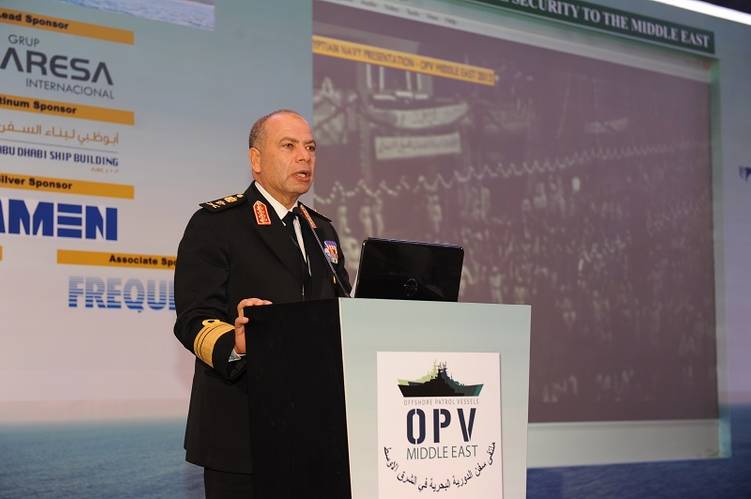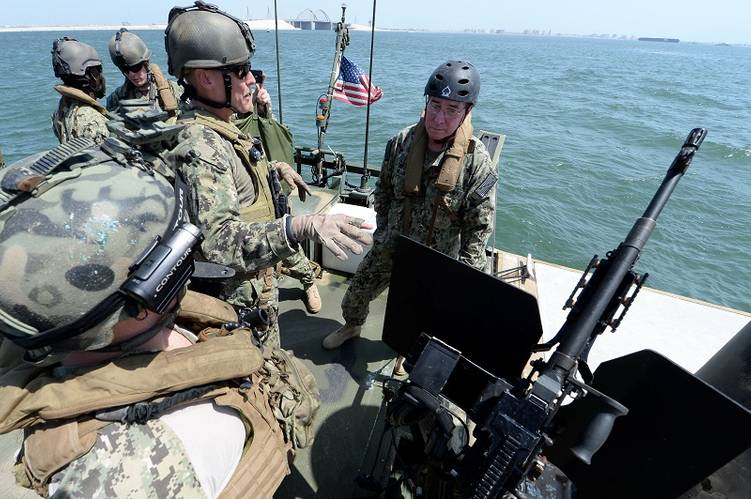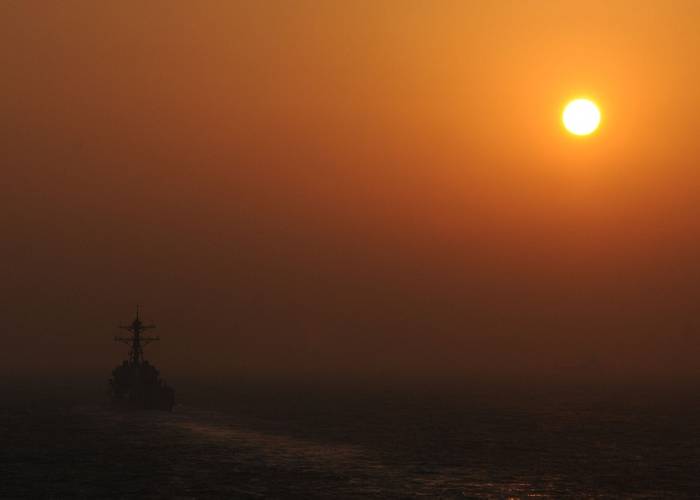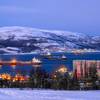“No one likes piracy.”
Maritime security is built upon mutual cooperation, respect and 'responsibility to share' rather than 'need to know'
Offshore Patrol Vessels Middle East 2013 delegates may share different perspectives, but agree on importance, responsibility of protecting global sea lanes for commerce
Attendees at the IQPC Offshore Patrol Vessels Middle East 2013 conference, which concluded on Dec. 11, agreed that that the safety and security of maritime commerce in the Arabian Gulf, Res Sea and their approaches, is an international responsibility shared by regional and international partners.
The conference was chaired by Rear Admiral (R) Ahmed Al Sabab Al Teneiji, former chief of naval forces for the UAE Navy.
The event focused on regional security cooperation; offshore patrol vessel design, procurement and operations; coastal surveillance; and maritime domain awareness.
Vice Admiral Osama El-Gendy, Chief of Naval Forces for the Egyptian Navy said the Suez Canal, which connects Red Sea and Mediterranean, is one of the most important sea routes in the world, and a vital east-west connection. It is also, he said, the longest canal in world. “Seventy percent of world trade crosses the canal.”
“Egyptian forces are committed to making the canal safe and secure, in cooperation with our partners,” he said.
El-Gendy described the sophisticated network of aviation assets, coastal radars, vessels on patrol and surveillance stations, networked by means of a coordination center. He also remarked that Egypt is cooperating with countries such as Saudi Arabia to secure the Red Sea.
Staff Commodore Ala’a Abdulla Seyadi, Commander of the Bahrain Coast Guard, talked about the challenge of small vessels that are not tracked by the Automated Information System (AIS). AIS is required by international law of vessels 300 tons or larger. Bahrain's coastal surveillance system seeks to identify the wooden dhows common in the Arabian Gulf, but most do not have AIS. Bahrain has 7,500 dhows alone, Seyadi said, and with the other Gulf nations combine there are many thousands more.
In delivering his keynote address, Vice Admiral John W. Miller, who commands the U.S. Naval Forces Central Command (NAVCENT), U.S. 5th Fleet and the Combined Maritime Forces, said that there has been an interesting upside to piracy in that it has become an area of agreement among nations. “No one likes piracy,” Miller said.
While he agreed that the multinational response to piracy has been effective, the number of nations participating in coalition anti-piracy operations is actually growing. And nations such as China, Russia, India and Iran are conducing independent patrols that are never the less conducted with some coordination and deconfliction.
During his remarks, Miller said that while Yemen continues to be faced with both challenges and opportunities, he applauded the fact that the Yemeni Coast Guard had just accepted an invitation to be the 30th member of Combined Maritime Forces.
Miller said multi-national engagement is important, adding that the U.S. conducts 25 exercises with GCC nations, and a total of 60 throughout the region each year.
There are 17,000 Sailors working within the NAVCENT AOR, with 10,000 at sea and 7,000 ashore, Miller said.
The multi-national security efforts are successful, he said. “Free flow of commerce in this region is a given fact.”
Emphasizing the importance of the Suez Canal, Miller said the U. S. Navy conducts 150-200 transits of the Suez Canal each year.
“Access to canal remains good, Miller said. “Security of the canal zone remains rock solid.”
Several of the speakers acknowledged the fact that Iran has participated in counter piracy operations, albeit independently. Other speakers alluded to the fact that while governments may be posturing politically, mariners at sea tend to find ways to work together pragmatically.
Commodore Zain Zulfiqar, who commanders Pakistan's Patrol Squadron 10, said that Pakistan is challenged by its geography just outside the Arabian Gulf in the North Arabian Sea and Gulf of Oman, where there is inhospitably dry and rocky terrain of the Makran Coast and vast marshy but arid areas of the Indus Delta, thick with mangrove swamps with many places for trouble to hide.
Captain EfthimiosMikros HN, Director, Plans and Policy Directorate on the General Staff of the Hellenic Navy, described the mission and operations of the NATO Maritime Interdiction Operational Training center.
Located at the Souda Naval Base, near the city of Chania on the Greek island of Crete, the NMIOTC’s mission is “To conduct the combined training necessary for NATO forces to better execute surface, sub-surface, aerial surveillance, and special operations activities in support of Maritime Interdiction Operations (MIO)”
The center improves allied naval units' expertise in Maritime Interdiction Operations through specific theoretical and practical training programs, and promotes skills, interoperability and co-operation among naval units through sea training and simulation, Mikros said.
Captain Robert T. Hendrickson, who commander US Coast Guard Patrol Forces Southwest Asia and serves as Commander Task Force (CTF) 55.1, discussed the latest in the Coast Guard's technologies, tactics and procedures. He also shared his experiences while service in the Pacific region conducting fisheries enforcement for the vast U.S. exclusive economic zone (EEZ). Hendrickson emphasized the importance of partnerships, and how the Navy and Coast Guard were able to embark shipriders from partner nations when the U.S. ships and cutters would be transiting through the adjoining EEZs of p[partner nations. The ship riders had the jurisdiction and authority to represent their nations and enforce the applicable rules and regulations in the appropriate EEZs, and by riding the U.S. ships through their own nation's EEZs would monitor and detain ships that were fishing illegally.
“Asymmetrical threats, now increasing and spanning from the West African coastline across to Central Asia, coupled to diminishing naval capabilities, particularly those of EU Member States and the US military due to sequestration and re-pivoting towards Asia, emphasize the need to move from military cooperation to military collaboration,” said Col. Martin Cauchi-Inglott of the Armed Forces of Malta, currently assigned to the European Union Military Staff in Brussels. “Key to this shift would be the ability to exchange information on the basis of 'responsibility to share' rather than one based 'need to know', not only nationally amongst agencies, but across borders as well.”
“In contrast to air spaces, which are divided into relatively clear Flight Information Regions, and aircraft that are identifiable through IFF, maritime spaces lack clarity and control due to differing jurisdictions, maritime zones which sometimes overlap with neighboring states, and AIS which does not always provide a true picture of the vessel acquired on radar. That said, the OPV Conference may be considered to be a good step in the right direction as it brought regional actors together, who echoed a similar notion for enhancing coordination amongst GCC players, which could only materialize once confidence and trust becomes the order of the day,” Cauchi-Inglott said.
The conference attendees, sponsors and exhibitors included a number of shipbuilders, systems and service providers.
“It was good to see the distinction between the political and practical level in regards to obtaining maritime security in the gulf. When it comes to the practical level I am sure that all industry is more than willing to engage with the various navies, coast guards, and other entities maintaining maritime domain awareness on how to get the best possible “set of eyes” on the troublemakers and make sure that this information can be shared for the benefit of all involved in this most important task,” said David Adgill Larsen, regional manager, Middle East, for Terma A/S.
“It was a great list of speakers for this conference and I especially found the discussion on the practical level on how to obtain the necessary maritime domain awareness intriguing. Just the mere discussion of necessary equipment like AIS, radars, and overarching systems for the sharing of information is necessary to obtain a common idea of what the standard should be in this field and also the requisite for involving industry so we can provide our knowledge on how to actually obtain this most important goal,” Larsen said.
opvmiddleeast.com

























